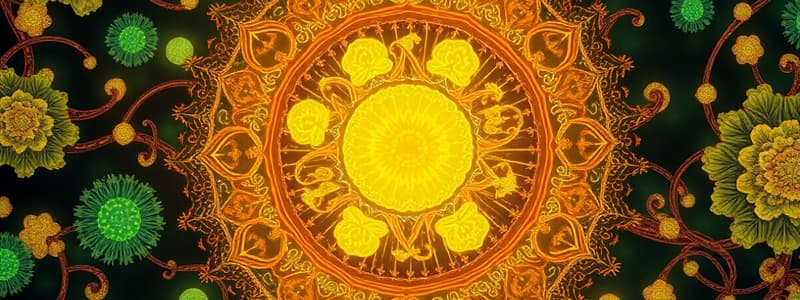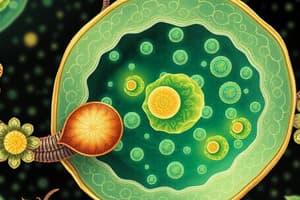Podcast
Questions and Answers
I mitocondri e i cloroplasti sono entrambi organelli presenti nelle cellule procariotiche.
I mitocondri e i cloroplasti sono entrambi organelli presenti nelle cellule procariotiche.
False (B)
Quale delle seguenti affermazioni è VERA riguardo ai mitocondri?
Quale delle seguenti affermazioni è VERA riguardo ai mitocondri?
- I mitocondri sono coinvolti nella respirazione cellulare. (correct)
- I mitocondri sono responsabili della fotosintesi.
- I mitocondri sono presenti solo nelle cellule vegetali.
- I mitocondri non hanno membrane.
- I mitocondri sono circondati da una singola membrana.
La teoria endosimbiontica suggerisce che i mitocondri e i cloroplasti erano una volta ______ organismi che sono stati inglobati da una cellula eucariotica ancestrale più grande.
La teoria endosimbiontica suggerisce che i mitocondri e i cloroplasti erano una volta ______ organismi che sono stati inglobati da una cellula eucariotica ancestrale più grande.
procariotici
Elenca due prove chiave a sostegno della teoria endosimbiontica.
Elenca due prove chiave a sostegno della teoria endosimbiontica.
Abbina le seguenti caratteristiche con i rispettivi organelli:
Abbina le seguenti caratteristiche con i rispettivi organelli:
Quale delle seguenti affermazioni NON è vera sul ruolo dei mitocondri e dei cloroplasti nella produzione o conversione di energia?
Quale delle seguenti affermazioni NON è vera sul ruolo dei mitocondri e dei cloroplasti nella produzione o conversione di energia?
Spiega brevemente come la teoria endosimbiontica spiega la doppia membrana presente nei mitocondri e nei cloroplasti.
Spiega brevemente come la teoria endosimbiontica spiega la doppia membrana presente nei mitocondri e nei cloroplasti.
La teoria endosimbiontica evidenzia l'interconnessione evolutiva tra le varie forme di vita e conferma l'importanza dei processi evolutivi come la selezione naturale.
La teoria endosimbiontica evidenzia l'interconnessione evolutiva tra le varie forme di vita e conferma l'importanza dei processi evolutivi come la selezione naturale.
Flashcards
Mitocondri
Mitocondri
Organelli nelle cellule eucariotiche che generano ATP tramite respirazione cellulare.
Cloroplasti
Cloroplasti
Organelli che effettuano la fotosintesi nelle cellule vegetali e algali.
Teoria endosimbiotica
Teoria endosimbiotica
Proposta che i mitocondri e i cloroplasti erano organismi prokariotici liberi inghiottiti da cellule eucariotiche.
DNA circolare
DNA circolare
Signup and view all the flashcards
Ribosomi
Ribosomi
Signup and view all the flashcards
Divisione per fissione binaria
Divisione per fissione binaria
Signup and view all the flashcards
Membrane doppie
Membrane doppie
Signup and view all the flashcards
Energia eucariotica
Energia eucariotica
Signup and view all the flashcards
Study Notes
Mitochondria and Chloroplasts
- Mitochondria and chloroplasts are organelles found in eukaryotic cells, having distinct evolutionary origins and functions.
- Both are double-membraned organelles; the inner membranes exhibit highly folded cristae (mitochondria) and thylakoids (chloroplasts), increasing surface area for their biochemical reactions.
- Mitochondria generate ATP (adenosine triphosphate) through cellular respiration, acting as the cell's powerhouses.
- Chloroplasts are present in plant and algal cells, performing photosynthesis, converting light energy into chemical energy.
Endosymbiotic Theory
- The endosymbiotic theory posits that mitochondria and chloroplasts were once independent prokaryotic organisms, engulfed by a larger, ancestral eukaryotic cell.
- This engulfment developed into a mutually beneficial symbiotic relationship.
- Evidence supporting the theory includes:
- Mitochondria and chloroplasts possess their own circular DNA, similar to bacterial DNA.
- Both organelles have ribosomes more akin in structure to bacterial ribosomes than eukaryotic ones.
- Both organelles reproduce via binary fission, a prokaryotic mode of reproduction.
- The double membranes likely originated from the engulfing eukaryotic host cell's membrane and the prokaryotic cell's original membrane.
- Mitochondria exhibit size and shape variability similar to prokaryotes, suggesting their prior independent existence.
Similarities and Differences
- Both mitochondria and chloroplasts possess their own genetic material, separate from the eukaryotic cell nucleus.
- Though both use aerobic reactions, mitochondria are involved in cellular respiration, while chloroplasts perform photosynthesis.
- Both participate in energy production or conversion, but through distinct mechanisms.
Conclusion
- The endosymbiotic theory offers a compelling explanation for the origin of these vital organelles, highlighting the evolutionary interconnectedness within the biological world.
- The adaptations following engulfment demonstrate the power of evolutionary processes through natural selection.
Studying That Suits You
Use AI to generate personalized quizzes and flashcards to suit your learning preferences.




